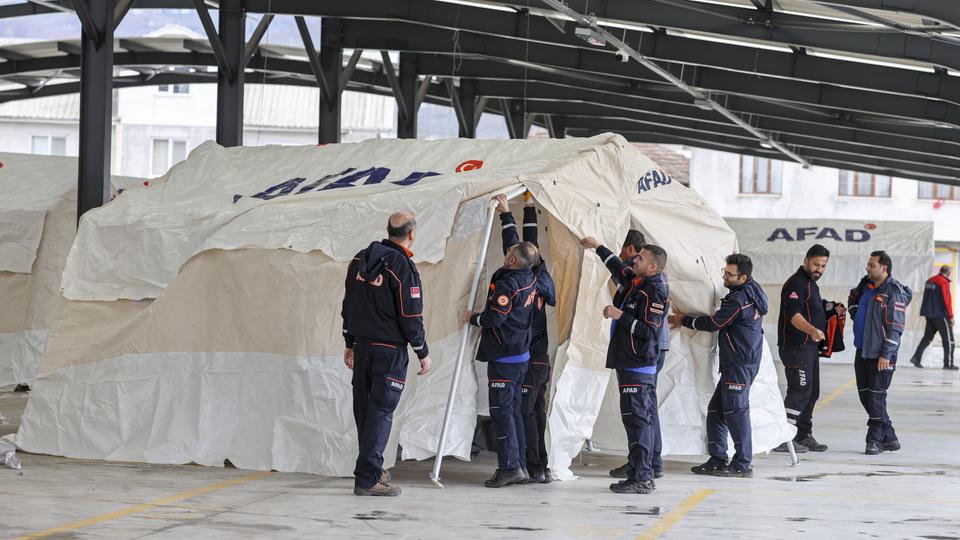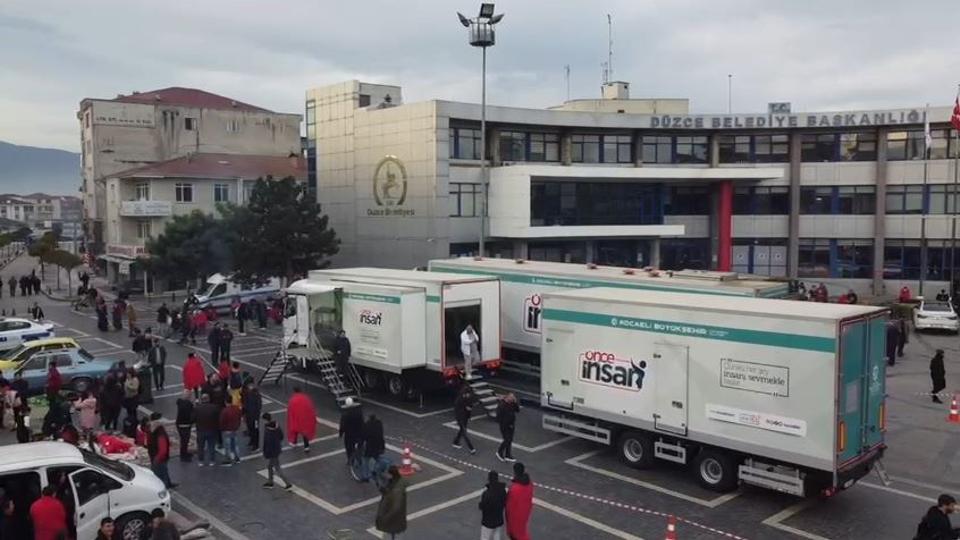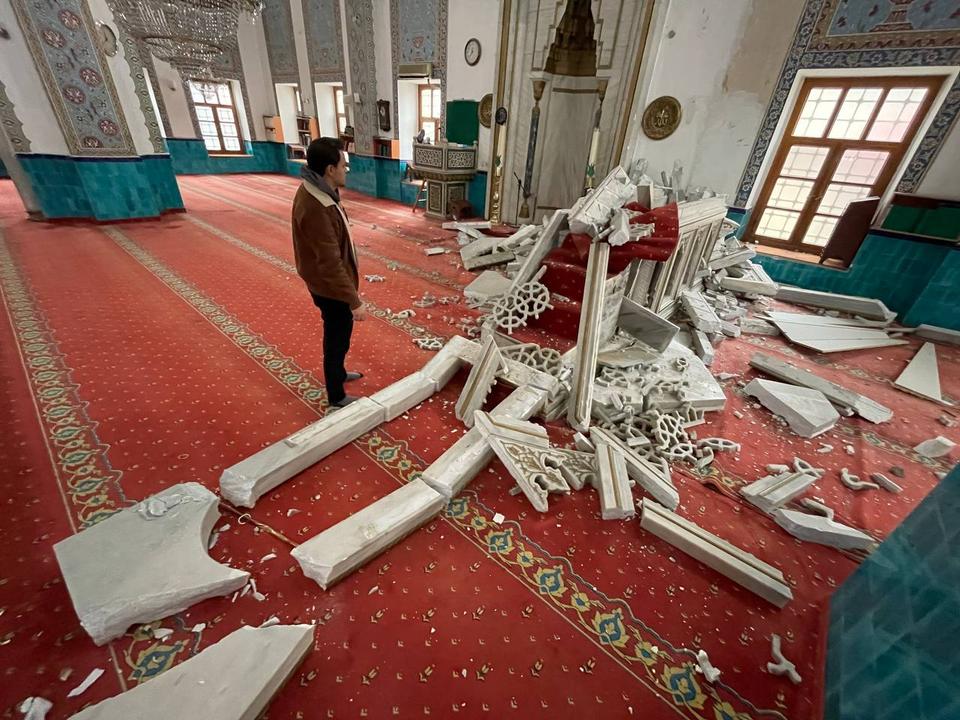Latest tremor in Duzce puts spotlight on the country's disaster preparedness while reminding people of the possibility of a major temblor referred to as 'the big one'.
 AFAD said a 5.9 magnitude earthquake centered in the Golyaka district struck Duzce at 4.08 a.m.
AFAD said a 5.9 magnitude earthquake centered in the Golyaka district struck Duzce at 4.08 a.m.
(0108GMT). (AA)
Türkiye's northwestern Duzce province was hit by a magnitude 5.9 tremor in the early hours of Wednesday, injuring at least 80 people, including one in critical condition, and damaging buildings while sending panicked people out on the streets.
Out of total, 23 people are receiving treatment at hospital, the Disaster and Emergency Management Authority (AFAD) said in a statement.
“Apart
from a severely injured patient, the general condition of our citizens
is good, they do not have any serious problems,” Health Minister
Fahrettin Koca previously told reporters in the capital Ankara.
The earthquake was also felt in the capital, Ankara, and in the country's largest city of Istanbul, according to officials and witnesses.
Interior Minister Suleyman Soylu, who arrived in Duzce immediately after the tremor, said there are no fatalities.
In 1999, Türkiye was hit by two deadly earthquakes. One of them, a powerful magnitude 7.1 shaker, which killed 710 people and injured 2,679, was centred in Duzce.
Just three months before that, a magnitude 7.6 quake also hit the country near the city of Izmit. The quake felt in Istanbul and many other areas, left major damage with at least 17,000 people killed.
The latest Duzce tremor has put into spotlight the government's disaster preparedness while reminding people of the oft-repeated warnings of experts about a possible major temblor that could hit the country anytime.
Türkiye sits atop one of the world's most seismically active zones.

For instance, Istanbul, a city of more than 15 million people, sits along the North Anatolian Fault, and people have been anticipating "the big one" for years.
With its history of powerful earthquakes, the government has been preparing for a major emergency.
Here's how disaster mitigation agencies are doing it:
Earthquake simulations
Last May, thousands of aid workers, volunteers and residents took part in one of the most extensive earthquake preparedness exercises in 18 locations in Istanbul.
The Disaster and AFAD simulated a magnitude 7.5 quake, carrying out mock evacuations, treatment of the injured and accommodations of displaced victims.
In Istanbul's district of Kagithane, residents were also given roles in an evacuation scenario from damaged buildings.
Earthquake drills are held every year to test the preparedness of disaster mitigation workers and volunteers, and the exercises also included search and rescue.

Building safety assessments
In 2019, Istanbul was reminded anew of those dangers following a magnitude 5.8 earthquake, the most intense in almost two decades. It saw people running from buildings and spilling into the streets.
Over the last nine years, the Environment, Urban Planning and Climate Change Ministry said it has already "evacuated or demolished" an estimated 673,000 units and structures that have not passed safety standards.
It was unclear how many of those buildings were in Istanbul. But according to a report published in 2020, an estimated 194,000 buildings could be heavily damaged or destroyed in case of a major earthquake in Istanbul.
As early as 2003, Istanbul already has an earthquake mitigation plan, which also includes the study and assessment of the safety of buildings and other structures.
Turkish Red Crescent and disaster management agency AFAD dispatch teams to supply residents with blankets and food after earthquake in Türkiye's Duzce provincehttps://t.co/ElghHRcIYa pic.twitter.com/pPn3gIgGpJ
— TRT World (@trtworld) November 23, 2022
'Drop, cover, hold'
Earlier this month, a nationwide drill was also held across the country as part of an "integrated disaster management strategy" in case of a major earthquake.
Several drills are carried out every year to test Türkiye's readiness.
The drills are part of a larger strategy that consists of three parts, including pre-disaster preparedness and risk reduction, response during the disaster and recovery after the disaster.
During the November 12 drill, residents across the country received an audible alert on their phones, along with an SMS notification in Turkish and English that read: "This is an AFAD earthquake drill announcement,".
The alert also reminded people "to drop, cover and hold" in the event of an earthquake.At the event, Turkish President Recep Tayyip Erdogan was quoted as saying that while "it is not possible to prevent an earthquake" a few minutes of learning the drill "will add a lifetime to our lives together".
As of 2021, nearly 57 million people have received information related to disaster preparations, while in 2022 multiple exercises were held to test Türkiye's readiness, the government said.
Social media is bold.
Social media is young.
Social media raises questions.
Social media is not satisfied with an answer.
Social media looks at the big picture.
Social media is interested in every detail.
social media is curious.
Social media is free.
Social media is irreplaceable.
But never irrelevant.
Social media is you.
(With input from news agency language)
If you like this story, share it with a friend!















0 Comments